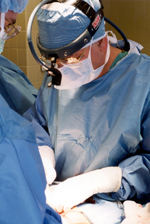 This section is directed to patients who have had a radical prostatectomy.
This section is directed to patients who have had a radical prostatectomy.
The articles as well as the questions and answers are focused on concerns of patients who are post surgery.
Readers who want more information can access the complete files of QUEST articles and Q&A’s, by clicking on the links on the left for these categories.
If, after reading these sections, your questions or concerns are not addressed, please contact us by clicking on the submit question link.
Quest Articles
Postoperative Radiotherapy Improves Cure Rate in High-Risk Prostate Cancer Patients
Help With Obtaining and Maintaining Erections
Recent Studies Raise Questions About Effectiveness Of Radioactive Seed Implantation
New (Experimental) Treatment Option for Prostate Cancer
Hormonal Therapy Treatment for Prostate Cancer
Requirements for Postoperative Radiation Therapy
Kegel Exercises/Sphincter Muscle Exercises
Will you provide me in writing the proper way to do kegel exercises post radical prostatectomy?
There are disagreements about what is the “proper" way. I like to have patients do Kegel exercises by imagining that they are urinating and then contracting the muscles to “cut off" the stream. They should hold it for only a second or two. Then, they should let the muscle rest for 5-10 seconds and repeat the contraction. I advise patients to do a set of 10 contractions four times a day – usually at breakfast, lunch, dinner, and bed time.
This allows the muscles to rest between exercise periods so the muscles do not remain in a fatigued state. In addition, I like the patient to actually stop the urinary stream once or twice when urinating to determine whether he is contracting the right muscles. If the stream stops, he is contracting the right muscles.
Taken together, this leads to about 50 contractions per day. This is like doing 50 pushups a day and will strengthen the muscles if done faithfully. More than 50 contractions may be too much and may leave the muscles fatigued – resulting in worse continence.
Recovery of Erections After Radical Prostatectomy
By Dr. William J. Catalona
Normally, men have erections every day. Thus, the normal physiology of the penis is to get an infusion of well oxygenated blood every day to keep the tissues healthy. After a radical prostatectomy, men usually have no erections for 3 to 6 months because of surgical trauma (manipulation and stretching of the nerves, sutures to control bleeders, etc.). Then erections begin to return as partial erections that gradually improve for up to 36 months. However, in the interim it is important to get blood into the penis at least 3 days per week to keep the tissues healthy. Blood flow is improved by several methods:
- Regular taking of Viagra-like medicines (I usually recommend Cialis 20 mg/day because it lasts
longer, but this drug causes some men to have muscle cramps and they have to switch to another); - Vacuum erection device;
- Injections into the penis of prostaglandin-like drugs that increase blood flow;
- Any sexual stimulation that causes erections normally. All patients should be encouraged to
use one or all of these methods for sexual rehabilitation beginning about 1 month after surgery.
Warning to Patients About "Peyronie's Disease"
By Dr. William J. Catalona
Peyronie’s disease is a term to describe curvature of the penis sometimes producing painful erections. The curvature is caused by patches of scar tissue that form in the compartments of the penis that fill with blood during an erection. Peyronie’s disease can be caused by injury to the penis during sexual activity when the penis is not completely rigid. With partial erections, the penis is more prone to buckle during intercourse tearing small blood vessels and causing hemorrhage into the tissues of the penis. This results in scarring that leads to unequal lengthening of the penis during subsequent erections.
To avoid the development of Peyronie’s disease after radical prostatectomy, we recommend the use of a vacuum erection device, intracavenosal injections or intraurethral suppositories to insure rigid erections during the early recovery phase of erectile function.
It is also important to insure that there is adequate lubrication during intercourse. Usually the curvature of Peyronie’s Disease straightens considerably although not always completely, with time. We have not found medication such as colchicine, vitamin E, or Potaba to be of much benefit. Peyronie’s disease usually can be prevented by the use of adequate lubrication and taking care to avoid trauma to the penis during sexual activity.
Penile Length After Surgery
By Dr. William J. Catalona
In connecting the bladder to the urethra, there often is some retraction of the penis, but the true length of the penis is unchanged. No penile tissue is lost. With return of erections and time, the tissues stretch and become more pliable and the retraction relaxes, and the perceived penile length returns to more like the way it was before surgery, although in some patients there remains some retraction.

